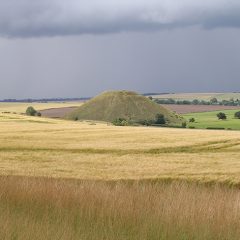The peaceful death of Hamish Miller at his home near St Ives, Cornwall, prompted an enormous and appreciative response. The Parallel Community, which Hamish recently helped to found, enjoyed over 47,000 messages on its website, a warranted response to a man who had given so much to both the alternative and earth mysteries movement. Hamish was well loved.
Hamish was always a Scot, but he was not always involved in alternative ideas. He spent his childhood near Stirling and attended Heriot Watt University in Edinburgh, where he graduated in engineering. After a career in this discipline, eventually owning his own company, he underwent a near-death experience (NDE) while under the surgeon’s knife, and this totally redirected his attentions to other matters that were to occupy the final thirty years of his life. He moved to a 12 acre smallholding near Trencrom, a short distance from Hayle and St Ives, where he set up a fully equipped blacksmith’s workshop/studio. He quickly made himself a local name as a fine and most useful craftsman, this leading to later acclaim as a sculptor in metal. Commissions followed and his garden was dotted with graceful and humorous examples of his work.
It was in Cornwall, living under the powerful peak of Trencrom that Hamish first began to become interested in dowsing. He rapidly became very proficient indeed in this art, and in the late 80s, Hamish got together with another adopted Cornishman, the writer and historian Paul Broadhurst, and together they mounted one of the largest earth mysteries projects ever undertaken at the time. Travelling the length of what has since become known as the St Michael line – the longest line that can be drawn across southern Britain – they dowsed all the sites along it. Today the ‘Michael line’ is known to many people, at the time hardly anyone knew of it.
The Michael line passes through or adjacent to many of the prime sites in southern Britain and this includes many important megalithic sites such as Boscawen-un, the Hurlers and Avebury, as well as scores of churches named after the Saint, many perched on high tors and lower tumps, such as Glastonbury Abbey and Tor, Bury St Edmunds Abbey and Cathedral, Brentor and Burrow Mump.
This lengthy quest resulted in the publication of the best selling earth mysteries book of all time, The Sun and the Serpent, in the late 1980s. Building on work undertaken previously by his contemporary, John Michell, this book radically and practically approached the study of the interaction between Man and Landscape, and formed a precursor to the phenomenology movement in academic archaeology.
